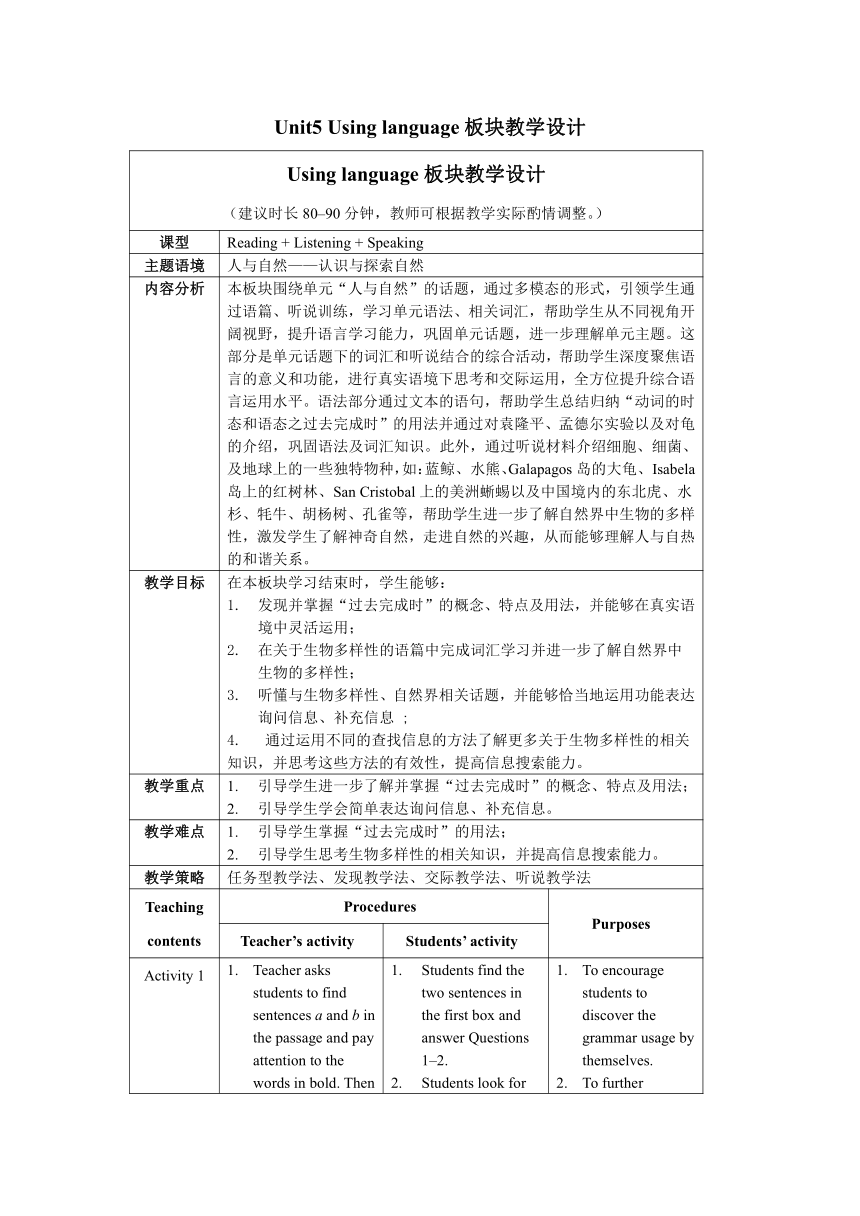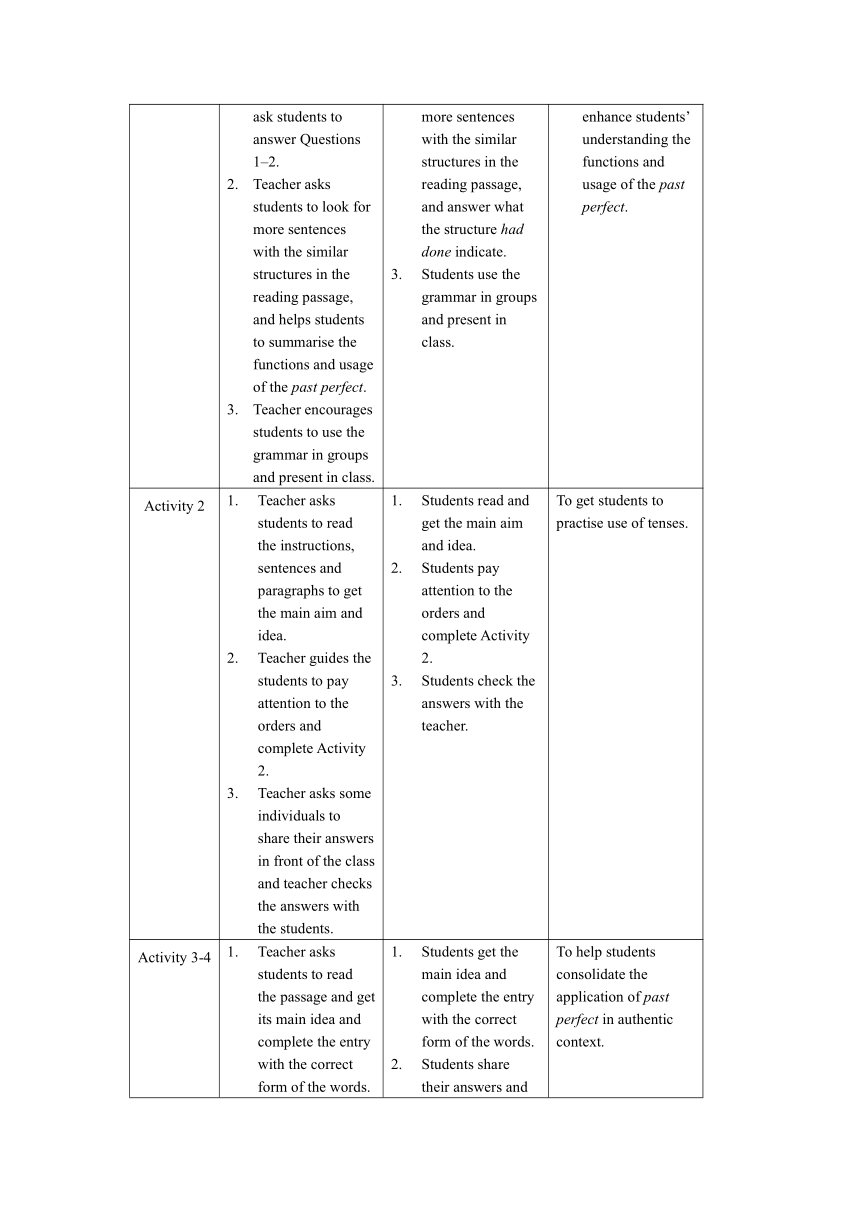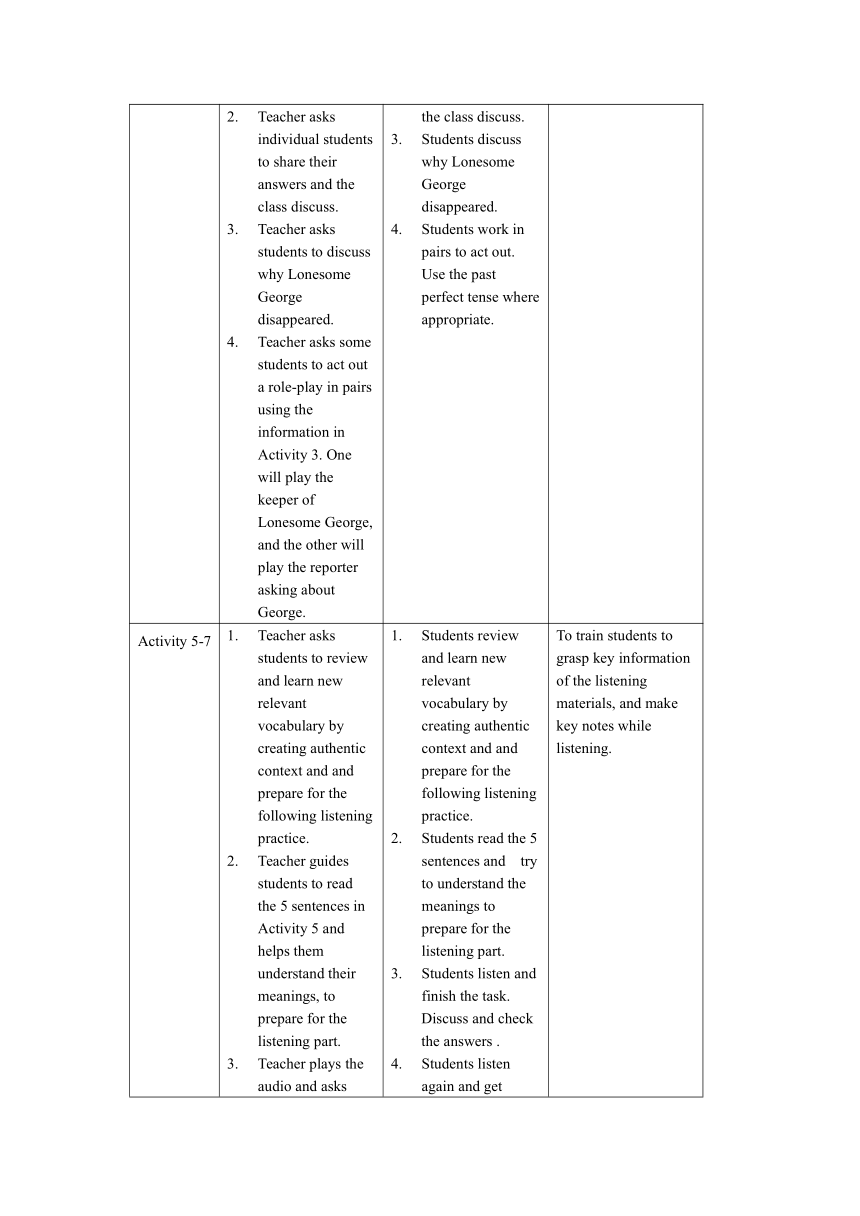外研版(2019)高中英语选择性必修第一册 Unit5 Revealing nature Using language 板块教学设计
文档属性
| 名称 | 外研版(2019)高中英语选择性必修第一册 Unit5 Revealing nature Using language 板块教学设计 |  | |
| 格式 | docx | ||
| 文件大小 | 21.1KB | ||
| 资源类型 | 教案 | ||
| 版本资源 | 外研版(2019) | ||
| 科目 | 英语 | ||
| 更新时间 | 2023-03-02 20:42:51 | ||
图片预览



文档简介
Unit5 Using language板块教学设计
Using language板块教学设计 (建议时长80–90分钟,教师可根据教学实际酌情调整。)
课型 Reading + Listening + Speaking
主题语境 人与自然——认识与探索自然
内容分析 本板块围绕单元“人与自然”的话题,通过多模态的形式,引领学生通过语篇、听说训练,学习单元语法、相关词汇,帮助学生从不同视角开阔视野,提升语言学习能力,巩固单元话题,进一步理解单元主题。这部分是单元话题下的词汇和听说结合的综合活动,帮助学生深度聚焦语言的意义和功能,进行真实语境下思考和交际运用,全方位提升综合语言运用水平。语法部分通过文本的语句,帮助学生总结归纳“动词的时态和语态之过去完成时”的用法并通过对袁隆平、孟德尔实验以及对龟的介绍,巩固语法及词汇知识。此外,通过听说材料介绍细胞、细菌、及地球上的一些独特物种,如:蓝鲸、 水熊、Galapagos岛的大龟、 Isabela岛上的红树林、San Cristobal上的美洲蜥蜴以及中国境内的东北虎、水杉、牦牛、胡杨树、孔雀等,帮助学生进一步了解自然界中生物的多样性,激发学生了解神奇自然,走进自然的兴趣,从而能够理解人与自热的和谐关系。
教学目标 在本板块学习结束时,学生能够: 发现并掌握“过去完成时”的概念、特点及用法,并能够在真实语境中灵活运用; 在关于生物多样性的语篇中完成词汇学习并进一步了解自然界中生物的多样性; 听懂与生物多样性、自然界相关话题,并能够恰当地运用功能表达询问信息、补充信息 ; 4. 通过运用不同的查找信息的方法了解更多关于生物多样性的相关知识,并思考这些方法的有效性,提高信息搜索能力。
教学重点 引导学生进一步了解并掌握“过去完成时”的概念、特点及用法; 引导学生学会简单表达询问信息、补充信息。
教学难点 引导学生掌握“过去完成时”的用法; 引导学生思考生物多样性的相关知识,并提高信息搜索能力。
教学策略 任务型教学法、发现教学法、交际教学法、听说教学法
Teaching contents Procedures Purposes
Teacher’s activity Students’ activity
Activity 1 Teacher asks students to find sentences a and b in the passage and pay attention to the words in bold. Then ask students to answer Questions 1–2. Teacher asks students to look for more sentences with the similar structures in the reading passage, and helps students to summarise the functions and usage of the past perfect. Teacher encourages students to use the grammar in groups and present in class. Students find the two sentences in the first box and answer Questions 1–2. Students look for more sentences with the similar structures in the reading passage, and answer what the structure had done indicate. Students use the grammar in groups and present in class. To encourage students to discover the grammar usage by themselves. To further enhance students’ understanding the functions and usage of the past perfect.
Activity 2 Teacher asks students to read the instructions, sentences and paragraphs to get the main aim and idea. Teacher guides the students to pay attention to the orders and complete Activity 2. Teacher asks some individuals to share their answers in front of the class and teacher checks the answers with the students. Students read and get the main aim and idea. Students pay attention to the orders and complete Activity 2. Students check the answers with the teacher. To get students to practise use of tenses.
Activity 3-4 Teacher asks students to read the passage and get its main idea and complete the entry with the correct form of the words. Teacher asks individual students to share their answers and the class discuss. Teacher asks students to discuss why Lonesome George disappeared. Teacher asks some students to act out a role-play in pairs using the information in Activity 3. One will play the keeper of Lonesome George, and the other will play the reporter asking about George. Students get the main idea and complete the entry with the correct form of the words. Students share their answers and the class discuss. Students discuss why Lonesome George disappeared. Students work in pairs to act out. Use the past perfect tense where appropriate. To help students consolidate the application of past perfect in authentic context.
Activity 5-7 Teacher asks students to review and learn new relevant vocabulary by creating authentic context and and prepare for the following listening practice. Teacher guides students to read the 5 sentences in Activity 5 and helps them understand their meanings, to prepare for the listening part. Teacher plays the audio and asks students to listen and finish the task in Activity 5. Discuss and check the answers in groups. Teacher asks students to listen again and get specific information to finish Activity 6. Ask the students to discuss knowledge on cell and bacterium in groups and share in class. Teacher asks students to discuss relevant sentence structures in Activity 7 and pay attention to the pragmatic function. Teacher asks students to make dialogues by using the sentence structures. Students review and learn new relevant vocabulary by creating authentic context and and prepare for the following listening practice. Students read the 5 sentences and try to understand the meanings to prepare for the listening part. Students listen and finish the task. Discuss and check the answers . Students listen again and get specific information to finish Activity 6. Discuss knowledge on cell and bacterium in groups and share in class. Students discuss relevant sentence structures in Activity 7 and pay attention to the pragmatic function. Students make dialogues by using the sentence structures. To train students to grasp key information of the listening materials, and make key notes while listening.
Activity 8 Teacher asks students to look at the pictures and video. Teacher asks students to read the materials on Page 54 respectively and answer Question 1 and 2. Teacher checks the answers with the students. Students look at the pictures and video. Students read the materials on Page 54 respectively and answer Question 1 and 2. Students check the answers with the teacher. To arouse their interest in reading. To help students know more species to enlarge their knowledge about biodiversity To help students improve their ability of getting information.
Activity 9 Teacher guides students to review the passage to consolidate. Teacher asks students to discuss the vocabulary in Activity 9 in groups. Teacher asks students to read the paragraphs on Page 55 respectively and complete the task. Teacher asks some individuals to share their answers with the class. Students review the passage to consolidate. Students discuss the vocabulary in Activity 9. Students read the paragraphs on Page 55 respectively and complete the task. The representative of each group presents their view. To consolidate vocabulary and knowledge to lead in “the Galapagos Islands”. To help students deeply understand biodiversity.
Activity 10 Teacher asks students to look at the pictures of the species native to different regions of China. Talk about biodiversity in China using the words and expressions in Activity 5 and 9. Teacher divides students into pairs and asks them to choose one species they are interested in and collect information, study and discuss its evolution and present situation according to the pictures. Teacher asks students to discuss in groups and add more information from other groups. Teacher asks students to discuss using sentence structures in Activity 7 and vocabulary in Activity 8 and 9. Teacher asks students to share what they discussed in groups and report their data, and other groups make supplements and comment. Teacher arrange homework: To introduce species in their home town. Students look at the pictures, talking about biodiversity in China. Students choose one species and collect information, study and discuss its evolution and present situation according to the pictures. Students discuss in groups and add more information from other groups. Students discuss using sentence structures in Activity 7 and vocabulary in Activity 8 and 9. Students share what they discussed in groups and report their data, and other groups make supplements and comment. Students finish the homework. To help students understand the biodiversity in China. To strengthen students’ ability of using theme-related language to express views. To consolidate and use what they have learned.
Using language板块教学设计 (建议时长80–90分钟,教师可根据教学实际酌情调整。)
课型 Reading + Listening + Speaking
主题语境 人与自然——认识与探索自然
内容分析 本板块围绕单元“人与自然”的话题,通过多模态的形式,引领学生通过语篇、听说训练,学习单元语法、相关词汇,帮助学生从不同视角开阔视野,提升语言学习能力,巩固单元话题,进一步理解单元主题。这部分是单元话题下的词汇和听说结合的综合活动,帮助学生深度聚焦语言的意义和功能,进行真实语境下思考和交际运用,全方位提升综合语言运用水平。语法部分通过文本的语句,帮助学生总结归纳“动词的时态和语态之过去完成时”的用法并通过对袁隆平、孟德尔实验以及对龟的介绍,巩固语法及词汇知识。此外,通过听说材料介绍细胞、细菌、及地球上的一些独特物种,如:蓝鲸、 水熊、Galapagos岛的大龟、 Isabela岛上的红树林、San Cristobal上的美洲蜥蜴以及中国境内的东北虎、水杉、牦牛、胡杨树、孔雀等,帮助学生进一步了解自然界中生物的多样性,激发学生了解神奇自然,走进自然的兴趣,从而能够理解人与自热的和谐关系。
教学目标 在本板块学习结束时,学生能够: 发现并掌握“过去完成时”的概念、特点及用法,并能够在真实语境中灵活运用; 在关于生物多样性的语篇中完成词汇学习并进一步了解自然界中生物的多样性; 听懂与生物多样性、自然界相关话题,并能够恰当地运用功能表达询问信息、补充信息 ; 4. 通过运用不同的查找信息的方法了解更多关于生物多样性的相关知识,并思考这些方法的有效性,提高信息搜索能力。
教学重点 引导学生进一步了解并掌握“过去完成时”的概念、特点及用法; 引导学生学会简单表达询问信息、补充信息。
教学难点 引导学生掌握“过去完成时”的用法; 引导学生思考生物多样性的相关知识,并提高信息搜索能力。
教学策略 任务型教学法、发现教学法、交际教学法、听说教学法
Teaching contents Procedures Purposes
Teacher’s activity Students’ activity
Activity 1 Teacher asks students to find sentences a and b in the passage and pay attention to the words in bold. Then ask students to answer Questions 1–2. Teacher asks students to look for more sentences with the similar structures in the reading passage, and helps students to summarise the functions and usage of the past perfect. Teacher encourages students to use the grammar in groups and present in class. Students find the two sentences in the first box and answer Questions 1–2. Students look for more sentences with the similar structures in the reading passage, and answer what the structure had done indicate. Students use the grammar in groups and present in class. To encourage students to discover the grammar usage by themselves. To further enhance students’ understanding the functions and usage of the past perfect.
Activity 2 Teacher asks students to read the instructions, sentences and paragraphs to get the main aim and idea. Teacher guides the students to pay attention to the orders and complete Activity 2. Teacher asks some individuals to share their answers in front of the class and teacher checks the answers with the students. Students read and get the main aim and idea. Students pay attention to the orders and complete Activity 2. Students check the answers with the teacher. To get students to practise use of tenses.
Activity 3-4 Teacher asks students to read the passage and get its main idea and complete the entry with the correct form of the words. Teacher asks individual students to share their answers and the class discuss. Teacher asks students to discuss why Lonesome George disappeared. Teacher asks some students to act out a role-play in pairs using the information in Activity 3. One will play the keeper of Lonesome George, and the other will play the reporter asking about George. Students get the main idea and complete the entry with the correct form of the words. Students share their answers and the class discuss. Students discuss why Lonesome George disappeared. Students work in pairs to act out. Use the past perfect tense where appropriate. To help students consolidate the application of past perfect in authentic context.
Activity 5-7 Teacher asks students to review and learn new relevant vocabulary by creating authentic context and and prepare for the following listening practice. Teacher guides students to read the 5 sentences in Activity 5 and helps them understand their meanings, to prepare for the listening part. Teacher plays the audio and asks students to listen and finish the task in Activity 5. Discuss and check the answers in groups. Teacher asks students to listen again and get specific information to finish Activity 6. Ask the students to discuss knowledge on cell and bacterium in groups and share in class. Teacher asks students to discuss relevant sentence structures in Activity 7 and pay attention to the pragmatic function. Teacher asks students to make dialogues by using the sentence structures. Students review and learn new relevant vocabulary by creating authentic context and and prepare for the following listening practice. Students read the 5 sentences and try to understand the meanings to prepare for the listening part. Students listen and finish the task. Discuss and check the answers . Students listen again and get specific information to finish Activity 6. Discuss knowledge on cell and bacterium in groups and share in class. Students discuss relevant sentence structures in Activity 7 and pay attention to the pragmatic function. Students make dialogues by using the sentence structures. To train students to grasp key information of the listening materials, and make key notes while listening.
Activity 8 Teacher asks students to look at the pictures and video. Teacher asks students to read the materials on Page 54 respectively and answer Question 1 and 2. Teacher checks the answers with the students. Students look at the pictures and video. Students read the materials on Page 54 respectively and answer Question 1 and 2. Students check the answers with the teacher. To arouse their interest in reading. To help students know more species to enlarge their knowledge about biodiversity To help students improve their ability of getting information.
Activity 9 Teacher guides students to review the passage to consolidate. Teacher asks students to discuss the vocabulary in Activity 9 in groups. Teacher asks students to read the paragraphs on Page 55 respectively and complete the task. Teacher asks some individuals to share their answers with the class. Students review the passage to consolidate. Students discuss the vocabulary in Activity 9. Students read the paragraphs on Page 55 respectively and complete the task. The representative of each group presents their view. To consolidate vocabulary and knowledge to lead in “the Galapagos Islands”. To help students deeply understand biodiversity.
Activity 10 Teacher asks students to look at the pictures of the species native to different regions of China. Talk about biodiversity in China using the words and expressions in Activity 5 and 9. Teacher divides students into pairs and asks them to choose one species they are interested in and collect information, study and discuss its evolution and present situation according to the pictures. Teacher asks students to discuss in groups and add more information from other groups. Teacher asks students to discuss using sentence structures in Activity 7 and vocabulary in Activity 8 and 9. Teacher asks students to share what they discussed in groups and report their data, and other groups make supplements and comment. Teacher arrange homework: To introduce species in their home town. Students look at the pictures, talking about biodiversity in China. Students choose one species and collect information, study and discuss its evolution and present situation according to the pictures. Students discuss in groups and add more information from other groups. Students discuss using sentence structures in Activity 7 and vocabulary in Activity 8 and 9. Students share what they discussed in groups and report their data, and other groups make supplements and comment. Students finish the homework. To help students understand the biodiversity in China. To strengthen students’ ability of using theme-related language to express views. To consolidate and use what they have learned.
